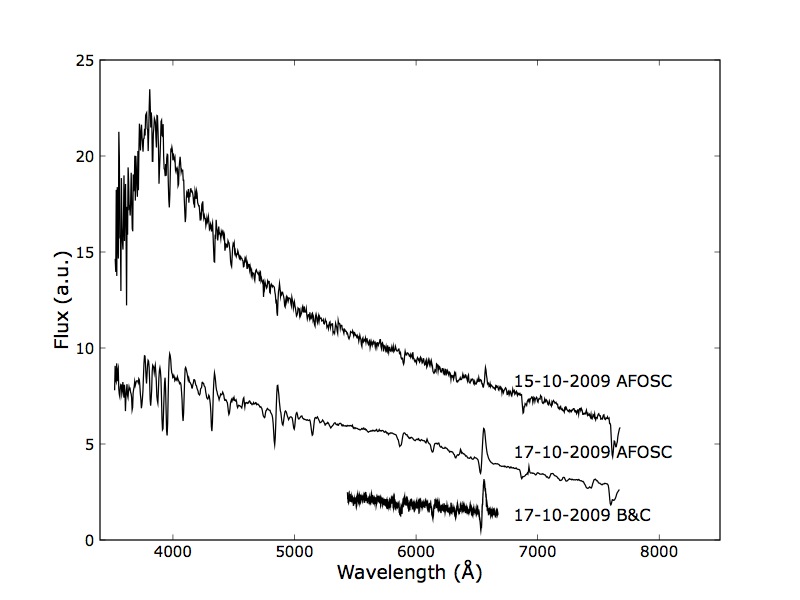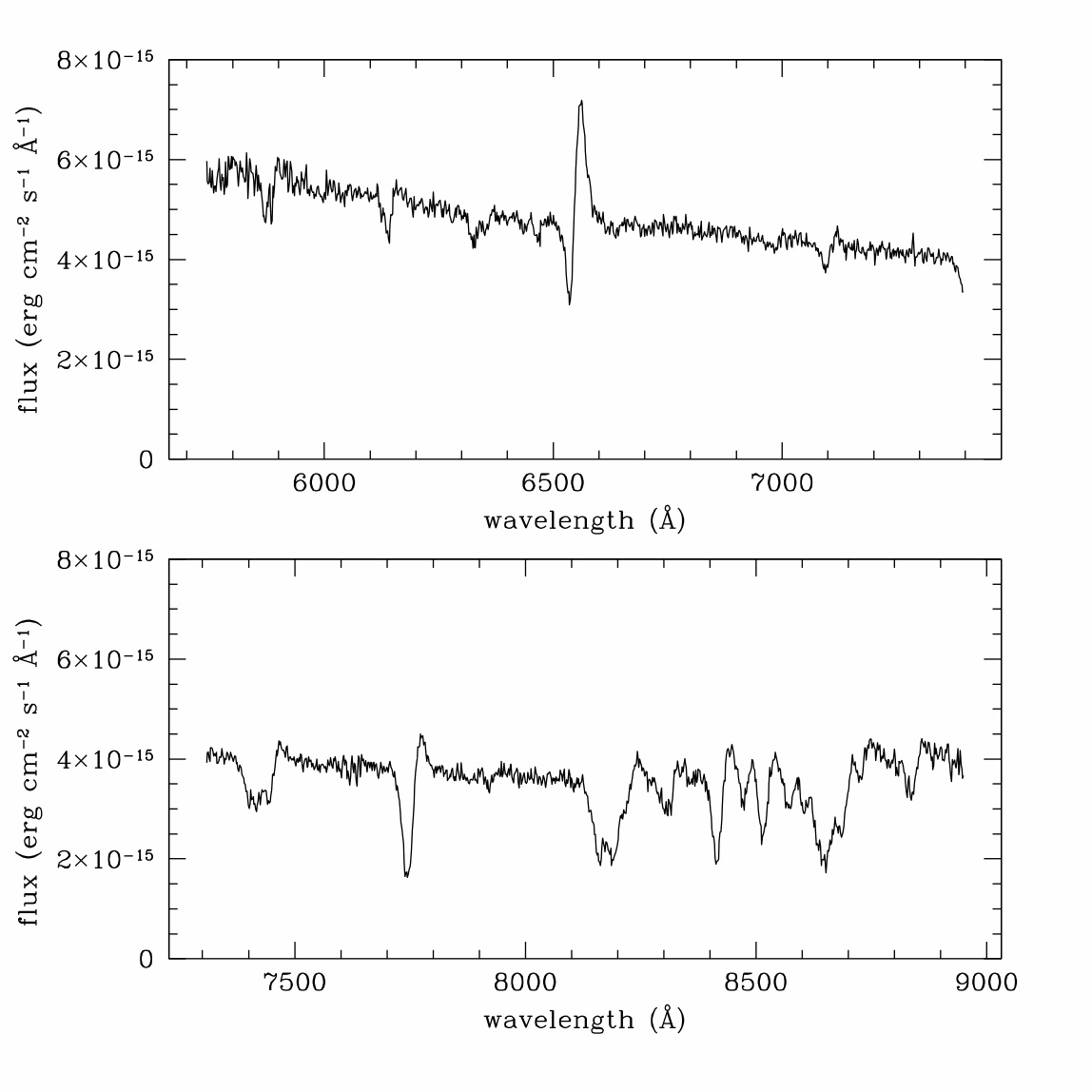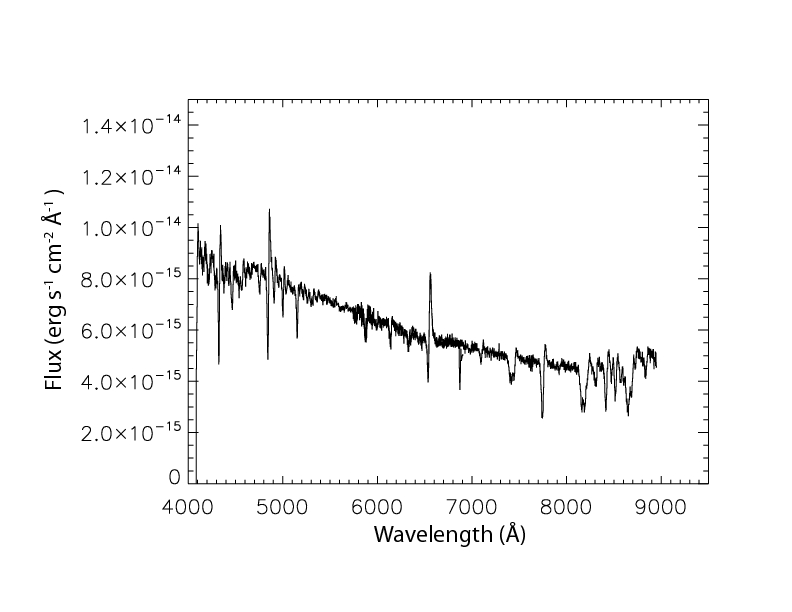M31N 2009-10b
Optical spectra reported by
Di Mille et al. 2009, ATel, 2248:
F. Di Mille (LCO/AAO), S. Ciroi (Padova University), H. Navasardyan,(INAF/OAPD), Sebastien Lepine
(American Museum of Natural History), Liese von Zee, Kate L. Barnes (Indiana University),
Dieter H. Hartmann, Sean D. Brittain,Adria C. Updike, Aman Kaur (Clemson University),
G. G. Williams(MMTO), W. Pietsch(MPE), A. Siviero, T. Saguner(INAF/OAPD), M.Orio(INAF/OAPD,
Univ. of Wisconsin), P. Rafanelli,A. Bianchini(Padova University)
The bright extragalactic nova M31N-2009-10b was observed at Asiago Observatory (Italy ) on 2009 Oct
15 and 17 and at KPNO (Kitt Peak National Observatory) near Tucson, AZ, on 2009 Oct 17 and 19. The
first spectrum (3x1200 sec exposures,range 355.0-766.0 nm,resolution 1.5 nm ) was obtained at Asiago
with the 1.82 telescope + AFOSC on October 15.02 UT, approximately 2 days after the discovery (see
CBET # 1967 ). It shows a prominent blue continuum with absorption lines of the Balmer series flanked
by a weak emission(see also CBET # 1980 ). In the second AFOSC spectrum (2400 sec. exposure,range
355.0-766.0 nm, resolution 2.3 nm) obtained on Oct. 17.88 UT the blue continuum became redder while
the flux of the emission lines increased. The object was observed on the same night also with the
Asiago 1.22 m telescope +Boller & Chivens spectrograph in the spectral range 543.2-667.0 nm and with
a spectral resolution of 0.15 nm. A clear P-Cygni profile at H-alpha shows a FWHM of 1100 km/s and a
velocity of the absorption component of about -1400 km/s.

Fig 1:
Asiago observatory spectra with the 1.82 m and 1.22 m telescopes.
Spectroscopic observations were carried out with HYDRA on the WIYN 3.5m telescope1 at KPNO using the
600@10.1 l/mm grating and the blue fiber bundle (3" fibers). A 300 s exposure was obtained on 2009
Oct 17 with wavelength coverage of 410-690 nm; 0.45 nm resolution. The spectrum shows a strong blue
continuum and prominent Balmer lines with P-Cygni profiles and Fe absorption lines. The Balmer lines
indicate blue-shifted absorption to -2500 km/s and red-shifted emission to at least +1600 km/s, with
a FWHM (emission-line) of about 1120 km/s. The nova was observed again with HYDRA on the WIYN 3.5m
telescope on 2009 Oct 19 with the same instrumentation and setup described above. Three 300 sec
exposures were obtained. The spectrum shows a strong red continuum and prominent Balmer lines in
emission. The Balmer lines exhibit weak P-Cygni profiles with blue-shifted emission to -1800 km/s
and red-shifted emission to at least 3200 km/s. The FWHM of Halpha is now approximately 1630 km/s.
An optical-red spectrum was obtained at the KPNO Mayall 4-meter telescope, on the night of 2009
October 17 (UT) with the RC spectrograph in conjunction with the LB1A thick CCD detector. The nova
was imaged through a 1.5 arcsecond slit, and the light was dispersed on the BL-181 grating (316 lines/mm)
in first order. This configuration yields spectral coverage of 5740A-8850A with a resolution of 1.74A per
pixel. Six exposures of 150 seconds each were obtained. The spectrum was calibrated using a HeNeAr arc
lamp and exposures of the spectro-photometric standard PG 0216+032. Based on these spectroscopic data
we find that M31N-2009-10b resembles the slowly rising, luminous FeII nova M31N-2007-11d, as described
in A. W. Shafter, et al. 2009, ApJ 690, 1148. We are also monitoring the nova photometrically with the
SARA 0.9m and the robotic S-LOTIS 0.6m telescope, both located at KPNO.
1 The WIYN Observatory is a joint facility of the University of Wisconsin, Indiana University,
Yale University, and the National Optical Astronomy Observatory.

Fig 2:
KPNO spectra with the Mayall 4.0 m telescope on 2009 Oct 17.

Fig 3:
KPNO spectra with HYDRA on the WIYN 3.5m telescope on 2009 Oct 17.
Spectral evolution of M31N 2009-10b, reported by
Barsukova et al. 2009, ATel, 2251:
E. Barsukova, V. Afanasiev, S. Fabrika, A. Valeev (Special
Astrophysical Observatory, Russia), K. Hornoch (Astronomical Institute,
Ondrejov, Czech Republic), W. Pietsch (MPE, Germany)
We obtained spectra of the nova N2009-10b in M31 (RA=00 42 20.81, Dec=+41
16 44.2). It was discovered by Koichi Itagaki on Oct. 10.629, http://www.cfa.harvard.edu/iau/CBAT_M31.html#2009-10b.
The spectrum has been taken with the SCORPIO spectral camera on Oct.
19.936 in a spectral range 382-838 nm with resolution 1.3 nm. We confirm
the FeII type of the nova suspected in ATEL#2248, however the spectrum
changed. We observe very strong and asymmetric HI emissions with extended
red wings and many strong FeII lines without P Cyg absorption components.
NaI D1,2 and OI (777.3 nm) show P Cyg-type line profiles with their absorption
peak at -1300 km/s. Equivalent widths of H-alpha and H-beta emissions are
19 and 9 nm, their widths corrected for the spectral resolution are FWHM
= 1500 and 1800 km/s. A full width at zero intensity in H-alpha line is
about of 6000 km/s. Heliocentric radial velocities of H-alpha, H-beta and
H-gamma line peaks are -300, -120, -80 km/s respectively. The radial velocities
of FeII, CaII K and NaI D1,2 lines are -80 km/s.
The nova brightness has been estimated in the same observations: Oct.
19.957 UT 16.98 +/-0.04 (B-band); 19.958, 16.46 +/-0.03(V-band); 19.960,
15.76 +/-0.04 (R-band).

Fig 4:
SAO spectra with SCORPIO on the Russian 6 m telescope (BTA) on 2009 Oct 19.9 UT.




